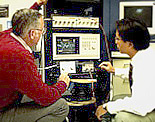Low-Complexity Rake Receivers in Wideband Wireless Channels

Dr. Robert Scholtz (left) and Moe Win (right)
review the signal from the impulse radio on an oscilliscope.
Presenter: Moe Win, Wireless Systems Research Department, AT&T Laboratories-Research
Host: Ramesh Rao, Director, San Diego Division, California Institute for Telecommunications and Information Technology - contact Prof. Rao through Leah Bellacera at lbellace@soe.ucsd.edu
Date: Tuesday, May 14, 2002
Time: 2:00 PM, Reception to Follow
Location: Engineering Building Unit I, Room 4307, (note: room change) UCSD (directions and parking information)
Live Webcast: http://earth.ucsd.edu:8080/ramgen/encoder/win.rm
Archived Webcasts available at: http://www.calit2.net/multimedia/archive.html
Courtesy: California Institute for Telecommunications and Information Technology [Calit²]
Abstract
[Presentation]
In this talk, we develop an analytical framework to quantify the effects of spreading bandwidth (BW) on wideband transmission systems operating in dense multipath environments. Our goal is to lay foundations and provide fundamental insights on how wideband reduced-complexity Rake receivers can best take advantage of multipath and a theoretical basis for deciding how many “fingers” should be included in the receiver architecture, thus saving cost and power consumption for handheld wireless devices. The focus of the talk is to characterize the performance of reduced-complexity Rake receivers, which are based on either partial combining (called PRake) or selective combining (called SRake). The first is suboptimum and combines the first arriving multipath components, while the second combines the strongest multipath components. Closed form expressions for the mean and the variance of the combiner output signal-to-noise ratio (SNR) as well as analytical symbol error probability (SEP) expressions of the Rake receiver are derived in terms of the number of combined paths, the spreading BW, and the multipath spread of the channel. The proposed problem is made analytically tractable by transforming the physical Rake paths, which are correlated when ordered, into the domain of a “virtual Rake” receiver with independent virtual paths. This enables a simple derivation of the mean, variance, and the SEP for any given spreading BW and an arbitrary number of combined paths. We then compare the performance of these low-complexity Rake receivers in ultra-wide bandwidth (UWB) propagation channels using statistical properties of the multipath profiles from extensive measurement campaigns. In such channels, we show that the simpler PRake receiver is almost as good as the SRake receiver even for a small number of fingers. Measurement and characterization of the UWB propagation channels will be presented if time permits.
Bio
Moe Z. Win (S'85-M'87-SM'97) received the B.S. degree (magna cum laude) from Texas A&M University, College Station, and the M.S. degree from the University of Southern California (USC), Los Angeles, in Electrical Engineering. As a Presidential Fellow at USC, he received both an M.S. degree in Applied Mathematics and the Ph.D. degree in Electrical Engineering. In 1987, he joined the Jet propulsion Laboratory (JPL), California Institute of Technology, Pasadena where he performed research on digital communications and optical systems for NASA space exploration missions. From 1994 to 1997, he was a Research Assistant with the Communication Sciences Institute at USC, where he played a key role in the successful creation of the Ultra-Wideband Radio Laboratory. Since 1998, he has been with the Wireless Systems Research Department, AT&T Laboratories-Research, Middletown, NJ, where he is a Principal Technical Staff Member. His main research interests are the application of communication, detection, and estimation theories to a variety of communications problems including time-varying channels, diversity, equalization, synchronization, signal design, ultrawide-bandwidth communication, and optical communications.
